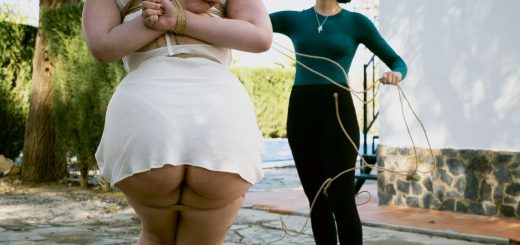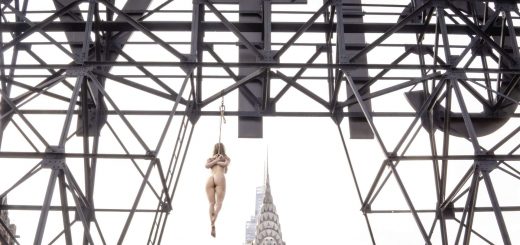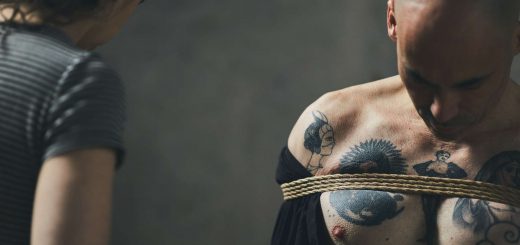Soptik & Sansei – Announcing presenters
Soptik and Sansei’s approach to ropes is about a deep connection between two people. They find this connection particularly in traditional kinbaku and are passionate about the Kinbaku LuXuria style that they are both certified for up to level 1. Soptik has been studying this style with Riccardo Wildties and Red Sabbath since 2013. Riccardo is a deshi of Naka Akira and his style is an interpretation of Naka Ryu more suited to western riggers and models.
Sansei and Soptik started their journey together a few years later and now not only study but also research their own interpretation of the style.
Their tying and their teaching includes classical patterns, aesthetics and also deep surrender to the core, dark emotions in semenawa and existing for each other. Through kinbaku they pursue things they are passionate about. Among the different flavours they tie and teach are objectification and exposure, from shame to humiliation, and some niche topics such as neck rope and arm binders.
Soptik has been studying Japanese bondage for a long time. He studied with Kinoko Hajime, Osada Steve, Nawashi Kanna, Arnoys Nicolas and Naka Akira. They taught him the basics, technique and also the movement, intimacy and simplicity of the ropes. Today his style is shaped by his studies with Riccardo Wildties.
Sansei has been doing ropes since 2017. Her approach to tying is specific with a deep surrender to her rigger, an almost altered state of being while tying, exploring the often dark emotions that ropes can bring and the beauty of them. Of particular importance to her is the naturalness of the experience and the effect of the rope on the human soul and body. She is not only a model, but also a rigger. She has been studying with Soptik since 2019 and the Kinbaku LuXuria style with Riccardo Wildties and Red Sabbath since 2022. The experience of both roles allows her to better understand and pass on deeper insight. She is passionate about Japanese aesthetics and philosophy, which is a great inspiration in her tying.
Although Naka style is their preferred way of tying today, they are open to enjoying spontaneity and fun with ropes, and their personal practice and teaching also includes lighter topics.
Find out more about their workshops at www.soptiksansei.com.
Workshops
Low hands Gote
(Workshop level: L1-3)
Hands behind the back. Tied. Open palms, fingers speaking more than words.
Low Hands Gote, when tied correctly, is a beautiful and often underestimated alternative to the classic Takate Kote. It is not just a variation for less flexible bodies or a weaker harness for floorwork – on the contrary!
Low Hands Gote brings many possibilities. Whether it is relief for overloaded, tired shoulders, aesthetic play in the form of retying or different hand positions, play with levering wrists that are not strictly glued to the back, or simply the strong emotional experience that comes from tying this structure.
In this workshop we will break down Naka style inspired Low Hands Gote from the first touch of the rope to its use. We will dive not only into technique and functionality, but also into the aesthetics, symbolism and beauty of bound hands – an ideal start for our next workshops, where we will try Gote in full suspensions.
Requirements: Single column tie, X friction, good rope handling, good ability to follow instructions.
Inversion with Low hands Gote
(Workshop level: L3)
Head-down suspensions (inversions) can often feel monotonous, both visually and emotionally. They become even more challenging when combined with the Low Hands Gote. In this workshop, we will explore how to use this tie in suspension, making the most of its strengths while learning to work around its weaknesses. We will examine its possibilities in upside down positions and discover how to transform a simple inversion into new shapes and emotions through the concept of tension ropes.
This workshop will build directly on the previous one. Once again, the main focus will be on Low Hands Gote, this time combined with a monoblock tie (butt basket), which fits it perfectly.
Requirements: Any Gote (Low hands Gote from our first workshop recommended), experience with suspensions.
Kata ashi with Low hands Gote
(Workshop level: L3)
It is often said that Gote does not work well in vertical (upright) suspensions. Let’s challenge this myth together – and at the same time understand why it exists. In the third workshop of the “Fall in Love with Low Hands Gote” series, we will explore how to integrate this structure into the iconic vertical tie Kata Ashi.
Kata Ashi (Jap. leg to shoulder) has many variations. In this workshop, we will focus on a strong, strict and overtied Naka style inspired version, which brings a very deep connection with our partner and session with strong progression through playful dynamics. Combined with Low Hands Gote, the load on the shoulders is reduced, allowing more space and time to dedicate to the experience, the session, and the aesthetic beauty of suffering and helplessness.
Requirements: Any Gote that is vertically stable (Low hands Gote from our first workshop recommended), experience with suspensions.



